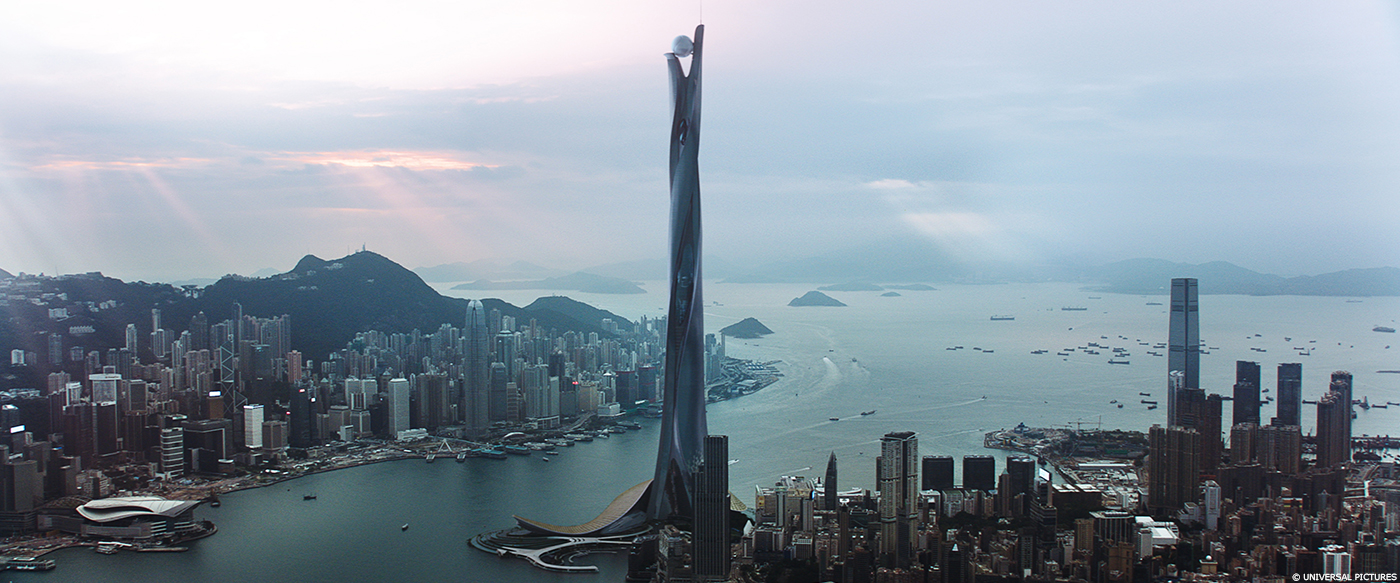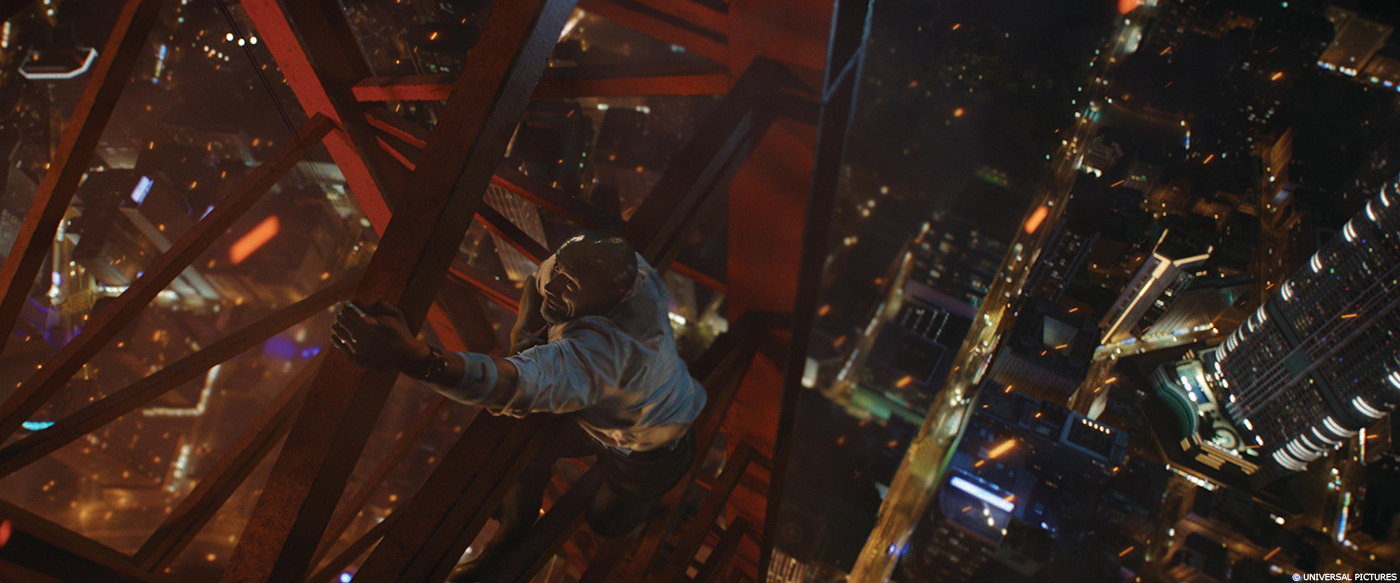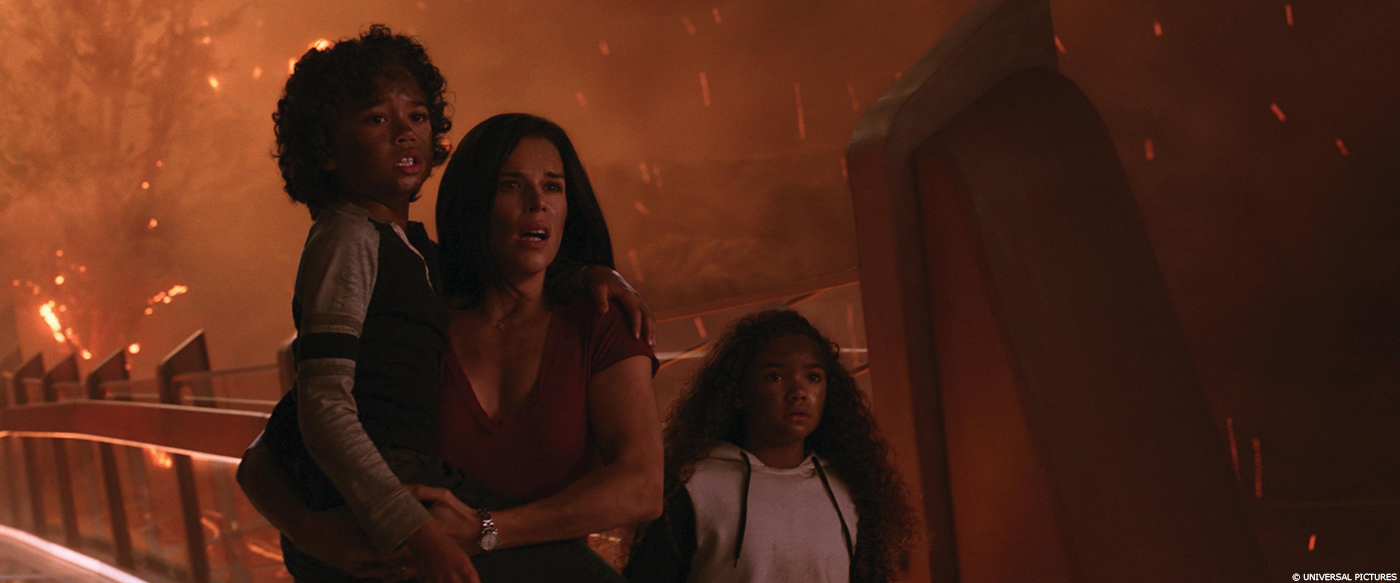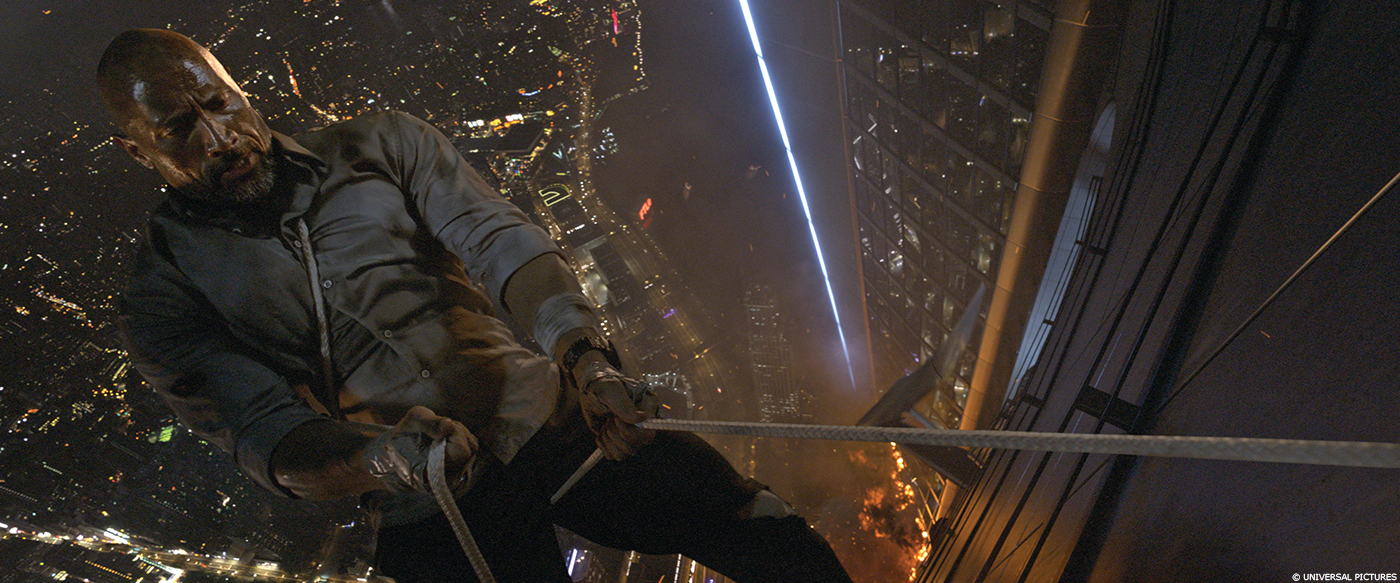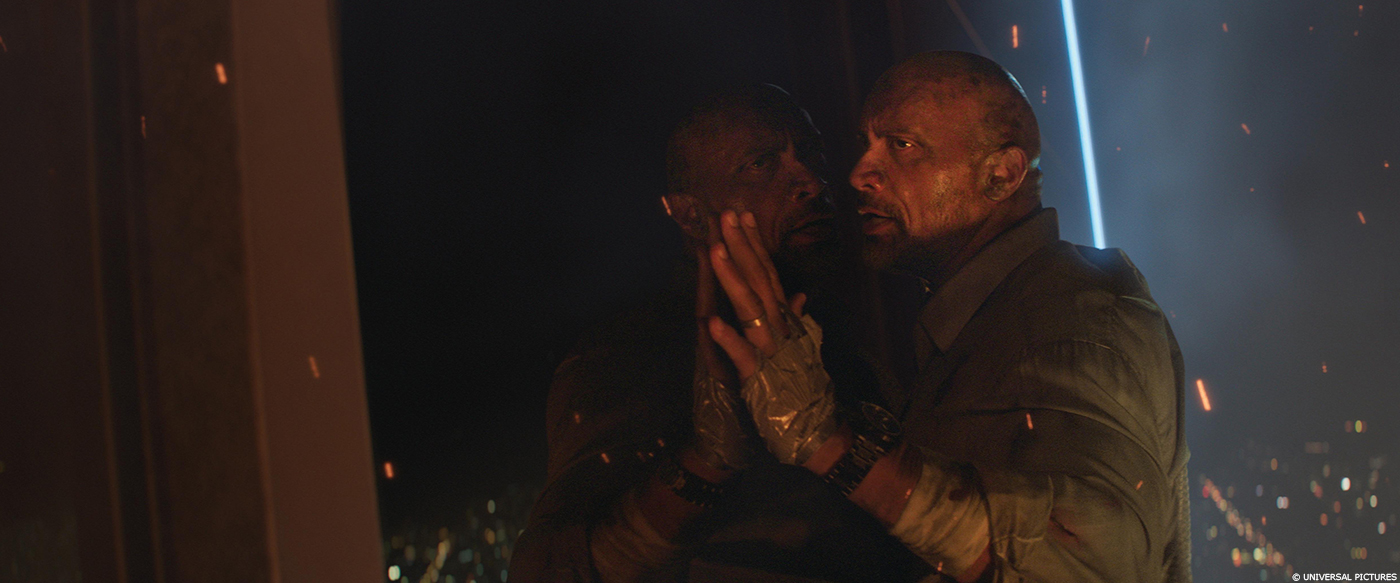Earlier this year, Craig Hammack told us about the work of ILM on BLACK PANTHER. He talks to us today about his work and the challenges on SKYSCRAPER.
How did you get involved on this show?
It was actually a result of having just worked with Petra Holtorf-Stratton on DEEPWATER HORIZON. She had been brought onto SKYSCRAPER and asked me to attend a meeting with Rawson to consult on how to achieve some of the intense fire scenes. It went well and I was asked to join the team.
How was the collaboration with director Rawson Marshall Thurber?
Rawson was incredibly collaborative and generous with us. He is a fan of movies and a fan of ILM’s, but hadn’t had a great deal of exposure to larger Visual Effects projects. It was very impressive how quickly he gained an understanding of the process and the right questions to ask, how comfortable he was discussing these massive effects shots, and how willing he was to accept suggestions on how to make them better.
What were his expectations and approaches about the visual effects?
With movies like this, which take place in and around a structure that doesn’t exist, and doesn’t have a real world equivalent, everyone goes into it knowing that there will be a lot of green or blue screen work. We had a very experienced Production Designer, Jim Bissell, and DP, Bob Elswit, so the methodologies were pretty easy to work out and understand. Everything building-wise would be shot on stages in Vancouver, and streetscape exteriors would be shot in Vancouver and transformed to look like Hong Kong. In Post it was clear that the main goal of the VFX would be to bring scale, vertigo, and danger to the film. Eddie Pasquarello, another ILM supervisor, covered the shoot for me as I finished up BLACK PANTHER, and got the initial development and shot work started for SKYSCRAPER.
How did you organize the work with your VFX Producer?
This show was quite an organizational challenge. It was a constant struggle to get the sheer number of shots, and the necessary massive visual effects shots, to squeeze into the budget. Because this project came on to our schedule a bit late it was determined early on that ILM would not have the capacity to manage all of the work, so we worked with Petra and Harrison Marks on the production side to come up with a strategy to bring in Iloura (now Method Studios), who we had worked well with on DEEPWATER HORIZON, to do a large chunk of work along with MPC, Image Engine, Whiskeytree, UPP, Mill, Umedia, Lola and Revolt 33. The graphics were provided by Perception and Cantina Creative. I supervised all but the MPC portion of the work along with my Associate, Jose Burgos. Near the end we also brought on fellow ILM supervisors, Eddie Pasquarello, Jeff White, and Tim Alexander for additional support.
How did you split the work amongst the ILM offices?
The ILM portion of the work was done at the offices in San Francisco and Vancouver. We share a data center and the render farm between those facilities so the work can freely flow and be distributed based on crew availability quite easily. I was lucky enough to have Jose Burgos join as my Associate Visual Effects Supe. He is at the Vancouver facility and so could help supervise the work up there. Shot-wise it seemed pretty even between the two facilities.
Can you tell us more about the previz and postviz work?
Previz and techvis were handled by The Third Floor. Key action sequences were done to inform the shoot and led by Javier Lopez-Duprey. The stunt and heavy CG shots were very technically demanding, and the previs was a great way to inform the crew and make sure everyone was on the same page to achieve Rawson’s vision.
How did you created the missing leg for the character of Dwayne Johnson?
It’s one of those traditional effects that is a little bit of a shooting challenge at times, which usually involves many departments coming together to solve the puzzle in very creative ways. In this case, Dwayne wore a green sock and bent his leg back in most shots, while a residual limb prosthetic was attached at the knee to show the scarred severed limb. This way there was something physically there for Dwayne to pull the metal prosthetic over for the hero shots. After that it becomes a lot of difficult cleanup and in some cases warps, to make things like clothes and posture look correct.
Can you explain in detail about the creation of the big tower, the Pearl?
As you can imagine the creation of the building was our biggest undertaking. The title of the film says it all. The entire story takes place in and around this CG structure so we knew it would need to be well-thought out and executed. Luckily, Jim Bissell and his team also recognized the challenge and gave us a tremendous head start. We received initial artwork and a blocking art model from them. Then Rene Garcia, our Model Supervisor, launched into a build that would continue to evolve over the course of the entire show. With things like this–a massive structure which will have specific sections that need to hold up to extreme detail–we often split it into subsections so that the level of detail doesn’t need to carry across the entire thing. These then get nested under the main asset and can easily be loaded or unloaded as needed. With this combination of detailed close-up work and wide establishing shots we also knew we would be splitting tasks between departments. The lighting group would handle most of the close-up work and our generalist group, led by Johanes Kurnia, would work on the massive establishing shots and everything involved with re-creating Hong Kong.
Another challenge for this enormous asset would be the need to share it amongst all the vendors. This required close collaboration and exchanging specifications between all parties.
What kind of references and indications did you received for the Pearl?
Aspects of the design for the Pearl are influenced by the work of Iraqi-British Architect, Zaha Hadid. We studied her work quite a bit. For tall skyscrapers we, of course, had excellent reference from the work we had done on MISSION IMPOSSIBLE: GHOST PROTOCOL with the Burj Khalifa. Unfortunately, there is no shortage of well-documented fire tragedies involving skyscrapers as well and, of course, Hong Kong itself is very well documented. For the interior we again looked at some Zaha Hadid spaces and for the park, a few interior park spaces in Singapore.
What was the real size of the various places inside the Pearl?
Interestingly, the interior park space had to be scaled up quite a bit from what would actually fit inside the building design in order to get the expansive feeling that Rawson was after. The diameter ended up about 400’ and the height around 680’. The Pearl itself is 1 km tall and had 220 floors, I believe.
The night shots and the reflective tower are really challenging. How did you handle these challenges?
We knew the reflections and the helicopter moves around the building would be a challenge. For this we sent a crew to Hong Kong to shoot nighttime photography in hopes of being able to stitch cyc’s together to reflect in the building. We built cyc’s for two heights to cover quite a bit of the reflection work. For the larger establishing all-CG shots though, we ended up building a large section of the surrounding Hong Kong streets and buildings in 3D to get an accurate parallax to contribute to the vertigo.
How did you use your experience of DEEPWATER HORIZON for this show?
DEEPWATER gave me a great understanding of the process of fire at night. How to expose for it, how the interactive light emitted from it acts, how the atmospheric and optical effects can be used to hide or enhance as needed, and just how much complexity is needed for it to sell danger. All that experience contributes to being able to efficiently plan and work through shots. The other great carryover was the relationship with Method Studios, and their supervisor Jason Billington, which was established on DEEPWATER.
Can you explain in detail about the various FX work especially the fire?
We are fortunate to have some of the best fire tools in the business and a collection of incredibly talented artists, who have had several shows to learn how to get the best out of those tools. For SKYSCRAPER we were able to build on the work of large-scale exterior fire from DEEPWATER HORIZON and the forest fires from ONLY THE BRAVE. The look of the CG fire is a complex blend of passes for interior fire, window sill fire, large source fire, smouldering surface smoke, embers, ash, paper debris, and large scale debris… all over a burnt-out husk of a building with broken windows, fully furnished interior rooms with collapsing ceiling pieces, floor-to-floor collision geometry, and varying wind gusts. It all combines to give you a mixture of contained burn and escalating chaos, which approaches what can be seen in most reference footage. The fire simulations are done in the ILM Plume engine interfaced through Houdini. It all gets fed through to our Generalists or Lighting TD’s so that they can use the fire as lights, and all that gets handed off to very skillfully deep composite (in most cases).
Can you tell us how you choose the various VFX vendors?
It’s always an interesting process. Some choices come from experience in working with vendors in the past, or supervisors. Some come from budget constraints and risk assessment. Others come from a simple scheduling constraint: Who is available to do what type of work right away? Method Studios, for example was there from the beginning. DEEPWATER proved that we worked well together, so it made sense. Image Engine was a relationship production had from past shows. Whiskeytree has a very fast and talented crew, especially for generalist work, so they were a good fit for some of the early daytime Pearl shots. I’ve worked with UPP in the past and they are great problem solvers who can take a loose idea and work through it without needing a lot of interaction. The trick is to have a good understanding of the complexities of the work and a knowledge of the limitations of available vendors, and then just match them up until you’re comfortable with the risks involved. The trickiest part on this one was the short schedule. It didn’t allow for a fall-back plan if any of them got into trouble.
How did you split the work amongst these vendors?
ILM took on the most difficult work: Detailed fire, large establishing shots, and detailed destruction, while MPC did the interior of the sphere (for both daytime and night). Method Studios had the bulk of the shot count doing set extension, leg replacement, and the helicopter crash among other things, including a good chunk of the crane climb. Image Engine took on a specific set of shots on the bridge in the park fire and the hanging shots on the side of the building, as well as a few of the erupting fire shots at the beginning of the park fire sequence. Whiskeytree had a majority of the daytime Pearl shots in the opening promotional video for the Pearl, as well as a great time lapse shot of the construction. UPP was brought on with very limited time to do some added shots of the building vents opening and closing as well as some interior room fire, the shots of the initial chemical reaction, and the explosion that starts the fire. Umedia was given mostly ferry travel and ferry landing shots, and Mill did some great work designing and executing the promotional video for the Pearl.
The vendors are all around the world. How did you proceed to follow their work?
Managing vendor work is always a tricky part of the process. In this case, I was fortunate enough to be working with some vendors and supervisors with whom I had some history. This gave me a level of confidence in exactly how much information and detail the reviews would need. Honestly, when you have so many vendors doing so much work. it’s to your benefit to spread out the time zones so that you can be reviewing work throughout the day instead of having to stack them up in the mornings. I was also fortunate enough to have Jose Burgos and Eddie Pasquarello looking over some of the vendor work.
Is there something specific that gives you some really short nights?
The schedule was the only thing that was really worrying. It was an incredibly short schedule for the complexity of the work and the budget complexities. It meant there was very little room for rethinking plans along the way.
What is your favorite shot or sequence?
Tough question. I think my favorite shot is actually the first fire shot we did. It was for the first trailer and is tight on Dwayne climbing the crane with the burning building in the background. It’s one of the best looks we get at the raging fire and all the complexity that was put into the shots. Usually, you get to the end of a movie and you wish you could go back to the first shots and do them over based on what you’ve learned and developed over the show. I didn’t have that feeling at all about this one.
What’s the VFX shots count?
I don’t actually know the final number, but I believe it was around 1300 shots.
What was the size of your team?
The ILM team was approximately 150 people. Worldwide across all the vendors I would estimate it closer to 1000 given the short schedule.
What is your next project?
I’m currently supervising ILM’s portion of CAPTAIN MARVEL.
A big thanks for your time.
// WANT TO KNOW MORE?
Industrial Light & Magic: Dedicated page about SKYSCRAPER on ILM website.
© Vincent Frei – The Art of VFX – 2018

